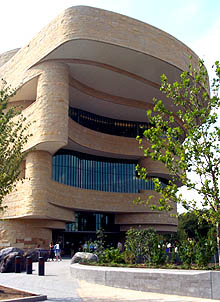A hatful of anecdotal indications suggests that for some non-Indians, the museum falters as "a framework of further meanings," identified by an aesthetician of the last century as the key to meaning itself; if true, this would mean at a minimum that Americans are not taking the NMAI experience home with them, talking it up to their friends and neighbors, connecting it with their daily preoccupations, modifying their mental models about the national Indian myths based on the museum visit.
The offhand phrases used by separate people (not looking for a quarrel, they requested anonymity) to describe the Potomac room in recent months seem too much alike to be coincidence: "Antiseptic." "Like a hospital waiting room." "Sterile."
It's doubtful most of them have any idea that this is deep water, that the museum's material objects are considered the secondary outcomes, artistic or artifactual as the case may be, of the cultural processes that produced them. There are about 800,000 of them in the NMAI collection, but unless you're interested in eating (the Mitsitam Cafe at the back is pretty much above criticism) or dropping a fair sum at the gift store (critics suggest the typical Washington tourist tends to go for less pricey trinkets as mementos to take back home), or taking in a performance or lecture and discussion (Rasmuson Theater), the ground floor doesn't have a lot to offer as the usual museum goes. A few display cases, a few scattered showpieces--that's it.
Upon returning to the Potomac in search of "stuff," the NMAI visitor is apt to absorb the museum's most topsy-turvy item of information: the museum begins on the fourth floor.
A more subtle problem:
The NMAI's original emphasis was on an uplifting celebration of the beauty and joy of Indian cultures. It was the institutional equivalent of a flute melody, a soaring hawk, or a wise elder in a Native-themed movie. It may have been respectful, even authentic, but it was also stereotypical. Whether positive or negative, a stereotype obscures the truth by flattening it into one dimension.
The things Gover mentioned--attention to detail, outreach efforts, temporary exhibits--don't seem to address this problem. What would address it is a change in the museum's philosophy or vision. Don't portray the good while ignoring the bad. Portray it all instead.
P.S. Those who aren't "modifying their mental models about the national Indian myths" should read Newspaper Rock. We'll modify your mental models for you. ;-)


Writerfella here --
ReplyDelete"Where's the stuff?" The modern generation is spoiled. They want everything about the world handed or spoon-fed to them, pre-cooked, pre-chewed, pre-digested. writerfella has been to the NMAI twice and he understands that it presents Native Americans as the mystery that they are, one that must be explored and discovered and solved. It is a story that as yet is not over, which is the real message of that museum...
All Best
Russ Bates
'writerfella'
The goal of most museums is to demystify their visitors, not to mystify them. I've seen no evidence that the NMAI's goal is any different.
ReplyDeleteSo the question is whether the NMAI is mystifying people intentionally or unintentionally. Just because you were mystified doesn't mean the NMAI intended that outcome.
Writerfella here --
ReplyDeleteFind "mystified" in writerfella's post. He 's waiting...
All Best
Russ Bates
'writerfella'
I'll find it in the dictionary instead, since you're apparently unaware of its meanings.
ReplyDeletehttp://dictionary.reference.com/browse/mystify
mys·ti·fy /?m?st??fa?/
–verb (used with object), -fied, -fy·ing.
1. to perplex (a person) by playing upon the person's credulity; bewilder purposely.
2. to involve in mystery or obscurity.
To spell it out for you, to mystify is to "involve in mystery or obscurity." You said the NMAI was trying to make Indians mysterious to visitors. That's synonymous with mystifying them.
Let me know if you need any other words explained to you. I'm here to help.